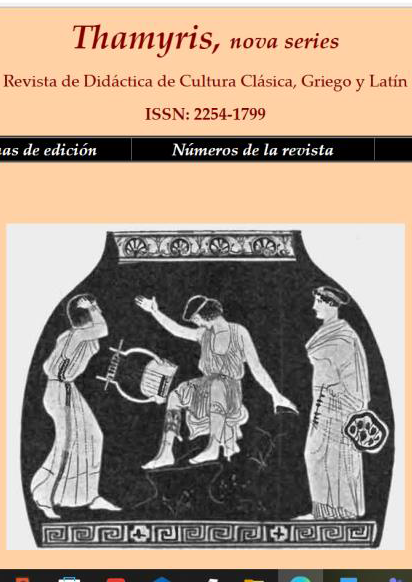Numismatics as a resource to teach Classical Culture. A didactic proposal
DOI:
https://doi.org/10.24310/thamyristhrdcc.v13i16297Keywords:
Classical Culture, Numismatics, Didactic resourcesAbstract
The content of this work is to present a different resource for the teaching of the subject of Classical Culture of 2nd and 4th of ESO, as part of a didactic methodology that has to be adapted to the diff erent rhythms, styles and levels of the students, in order to personalize learning processes.
In this case, a tool close to the student’s environment has been chosen and that may be attractive to him, such as the world of numismatics in the classical world, which in addition to serving as a didactic resource, is a source of historical knowledge.
To carry out the work, images of modern coins and bills have been used, which will allow the development of theoretical aspects of the Classical Culture curriculum, which will be complemented by a practical proposal, based on images of coins from the classical world. The latter will be done using book covers depicting coins, which will help develop language communication competence, while creating a broader and more enriching learning environment.
Downloads
Metrics
References
Arévalo, M.B. (2015), La iconografía en la moneda greco-romana. Banco Central de la República Argentina. Buenos Aires. <http://www.bcra.gov.ar/Pdfs/BCRAyVos/Cuadernillo_Moneda_GrecoRomanaDP.pdf> [2/11/2022].
Barret, D.S. (2000), Greeks and Roman coins. University of Queensland. Brisbane.
Bernard, S. (2018), “The social history of early Roman coinage”, The Journal of Roman Studies, vol. 108, 1-26.
<https://doi.org/10.1017/S0075435818000497> [29/11/2022].
Cornell, T. & Matthews, J. (1992), Grecia. Cuna de Occidente. Folio Ed., Madrid.
Ferrer, J.J. (2019), Economía de la antigua Roma: Guerra, comercio y finanzas, Síntesis, Madrid.
<https://www.sintesis.com/data/indices/9788491714385.pdf> [29/11/2022].
García Bellido, M. P. (2011), “Del origen de la moneda”, Zephyrvs, vol. 37, 397-409. <https://revistas.usal.es/index.php/0514-7336/article/view/7811> [7/11/2022].
Iglesias, J.M., & Santos, J. (2008), Vademécum para la epigrafía y numismática latinas, Santander.
Kovaliov, S.I. (1973), Historia de Roma, Akal, Madrid.
Sear, D.R. (2000), Roman coins and their values, Londres.
Scheid, J. et al. (2021), Infografías de la antigua Roma, Crítica, Barcelona.
Stevenson, S.W. (1889), A Dictionary of Roman Coins, Londres. < h t t p s : / / i a 6 0 0 2 0 7 . u s . a r c h i v e . o r g / 3 0 / i t e m s /dictionaryofroma00stev/dictionaryofroma00stev.pdf> [7/11/2022].
Vico, A. (2016), “El sistema monetario griego”, Documenta & Instrumenta, vol. 14, 199-222.
< h t t p s : / / r e v i s t a s . u c m . e s / i n d e x . p h p / D O C U / a r t i c l e /view/52901/48569> [17/11/2022].
Bases de datos numismáticos, en general
Britannica: Origins of coins
<https://www.britannica.com/topic/coin/Origins-of-coins> [14/11/2022].
Wildwinds: Base de datos de monedas antiguas (inglés)
<https://www.wildwinds.com/coins/index.html> [14/11/2022].
Bases de datos numismáticos, de moneda griega
O’Hara, R.J. Ancient greek coins of Miletus
<https://rjohara.net/coins/history/> [15/11/2022].
Coins in ancient Greece
<https://www.fleur-de-coin.com/currency/greek-coin-history> [30/11/2022].
Sylloge Nummorum Graecorum. Monedas griegas, por polis (inglés)
<http://www.sylloge-nummorum-graecorum.org/> [18/11/2022].
Bases de datos numismáticos, de moneda romana
Roman Numismatic Gallery
<http://www.romancoins.info/12C-Imperatorial.HTML> [29/11/2022].
Denarios. Base de datos de denarios y monedas de plata antiguas
<http://www.denarios.org/> [4/12/2022].





